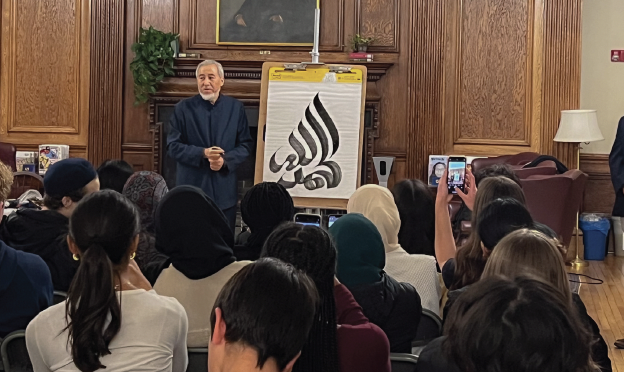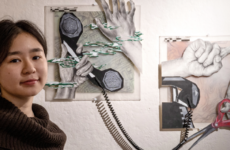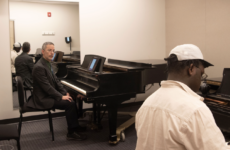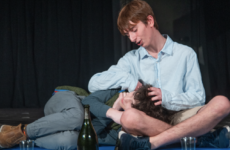
Mr. Mi’s work depicting the Arabic (سلام) and Chinese “寜” words for peace.

Mr. Mi demonstrated his take on traditional calligraphy during his presentation.
By Kaylin Lam ’27
Calligraphy is an ancient, traditional art form famed throughout the world, especially in Asia. From its precise but flowing brush strokes to the construction of the brush itself, there is much to be learned and appreciated. On the evening of December 1, the Choate community gathered in the Andrew Mellon Library Reading Room and witness the artistry of master calligrapher Mr. Haji Noor Deen Mi Guangjiang, who demonstrated his unique art form that brings Chinese and Arabic cultures together on one canvas.
Fluent in both Chinese and Arabic, Mr. Mi began the session by telling his story, with Chinese teacher Ms. Dan Zhao and Arabic teacher Mr. Yassine Benzinane translating. He started learning calligraphy when he was 17 years old and has never looked back since. Scarlett Park ’27, who attended the session, said, “It really shows how he took the time to craft his art and what it took to get where he is now.”
Throughout the workshop, Mr. Mi drew all kinds of intricate words and characters. He focused on the word “peace” — “salaam (سلام)” in Arabic. He used the word in his designs, including various bird shapes. Then, he combined the Arabic word with the Chinese character for peace, “ةr” (in simplified Chinese) or “寜” (in traditional Chinese).
Four student volunteers had the opportunity to try their hand at Arabic calligraphy. They were tasked with drawing a letter that seemed like a simple straight line at first glance. In reality, however, there were many intricate details that mattered, such as the angle of the tilt at the top, the curvature, and the length of the line. This exercise demonstrated how complex the art of calligraphy is.
Then, Mr. Mi drew the names of two volunteers in Arabic in the shape of a flower. “That was a highlight from the entire workshop,” Norah Wang ’27 said. “I learned from Mr. Mi that calligraphy is not just drawing lines on paper, but [that] there [are] actually quite a lot of other things involved.”
In addition to his multiple demonstrations, Mr. Mi also talked about the history of calligraphy. He explained that while the oldest traditional forms of Arabic calligraphy are precise, angular, and followed strict rules, the fusion with Chinese calligraphy shifted the style to be more art-based and free-flowing with Chinese additions, like seals.
This workshop, a collaboration between the Chinese Department, Arabic Department, and the Andrew Mellon Library (AML), drew awe from students and teachers. During his four-day visit to Wallingford, Mr. Mi also visited the Chinese and Arabic classes.
To Dr. Carol Chen-Lin, who heads the Chinese Department at Choate, this visit from Mr. Mi represented much more than just calligraphy. “In the realm of art, Teacher Mi exemplifies the idea that boundaries dissolve,” she said. “Through the eloquent strokes of his brush, we had the privilege of bearing witness to the harmonious exchange and fusion of these diverse cultural elements.”
Mr. Benzinane, the head of the Arabic and Middle Eastern Studies signature program, also shared how Mr. Mi’s work builds bridges between people. “This is a time of polarization in our country and around the world. Beautiful art that bridges cultures, hearts, and minds has a healing power to it,” he said. “It can bring down walls and boundaries of misconception and unite people around their most basic humanity.”
Although Park has some experience with Chinese calligraphy, this was her first experience with Arabic calligraphy. “How [Mr. Mi] made [calligraphy] personal to himself was really interesting to me, and I think it’s great that Choate is able to bring these types of people that I can learn from,” she said.
Mr. Benzinane, Dr. Chen-Lin, and AML Director Dr. Sherry Newman have all expressed hope to have more workshops that, in Mr. Benzinane’s words, “will showcase the intersection of storytelling, poetry, music, politics, and activism.” Through demonstrating this blend of art forms, the event urged students to appreciate how all cultures are connected in one way or another.




